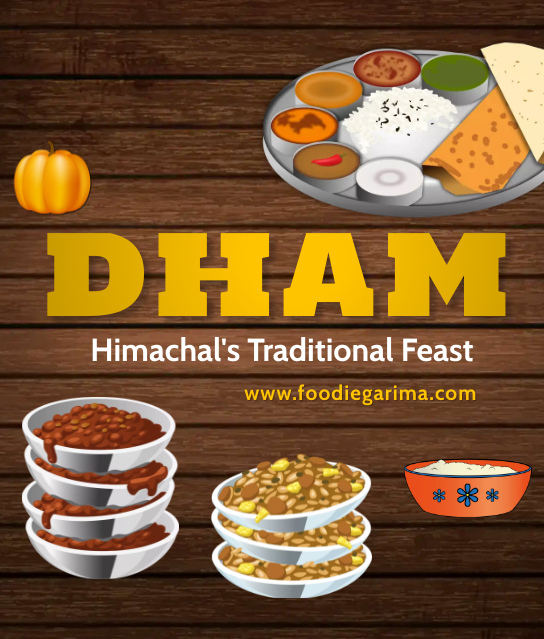28 January, 2023
DHAM | Himachal’s Traditional Feast

What Is DHAM?
“DHAM” is an elaborate feast in Himachal, prepared and served during special occasions like weddings, on the birth of a child, some religious and other special events. This is the most famous part of Himachal food which offers everyone an opportunity to get familiar with the various delicacies of the state.
Different types of pulses like Green Gram, Black Gram, Red Lentils are used to prepare ‘Dham’. These three pulses are collectively known as “Mash”.
In the olden times, vegetables were not the part of ‘Dham’. The entire feast was pulses based. But nowadays, the Botis add vegetables and milk solids also to it.
Besides these three kinds of pulses, Black Eyed Beans (Lobia), Red Kidney Beans (Rajma), Chickpeas (Chana), Split Red Gram (Tuar ki daal), Rice are also used.
Preparation Of Dham:
The speciality of ‘Dham’ is that it is absolutely simple food. No onion and garlic is added to it. Only Brahmins who are hereditary chefs prepare and serve the ‘Dham’. These Brahmin chefs are called “Boti” in Himachal’s language. Botis are skilled in the art of preparing ‘Dham’.
The food connected to weddings and festivals has always been considered sacred. Hence only Brahmins used to cook the food. These Brahmin chefs take bath before cooking and work bare feet. It takes them three to four hours to cook food for approximately 2000 people. Its preparation is not an easy task.
“Dham” is prepared and served like Kashmiri “Wazwan” . The entire preparation is done outdoors, not inside the house. Cooking is done on firewood and the vessels used to cook food for ‘Dham’ are made of Brass. These vessels are called ‘Charoti’ or ‘Baltohi’ in Himachal.
Concept of Dhuni:
An interesting part of the ‘Dham’ preparation is “Dhuni”. When Boti prepares food, they pour mustard oil on burning coals, add it to the pulses and cover it with a lid. It emits an enticing aroma. This procedure is called “Dhuni” in Himachal and is one of the oldest cooking techniques in the world.
This technique came into existence when nomads used to prepare food in hollows in the ground. The hollows used to get filled with smoke. This technique was later perfected across many eras in the name of smoked cooking.
Traditional Way of Serving:
Traditionally, it is served in plates made of dried Sal and Banyan tree leaves. These plates are called ‘Pattal’. This method of serving food on pattals, is one of the oldest methods of eating food.
Everybody eats from ‘pattals’ only. Nobody gets special plates and places. Whether it’s a shepherd or a person of the royal family, everyone sits on the floor and eats food together. Nobody gets up until everyone finishes. This represents a sense of equality.
First of all, ‘Rice’ is served with ‘Rajma Madra’ followed by other dishes ‘Chane ka Khatta’, ‘Mash’, ‘Khajoor ki Kadhi’, ‘Sepu Vadi’, ‘Matar Paneer’ and dessert ‘Meetha Bhaat’ (sweet rice cooked with jaggery) at the end. But the dishes cooked in ‘Dham’ vary from region to region in Himachal. This is not the same everywhere.
Dham is basically a vegetarian feast. But in some families or the royal families, they add meat also to it. They consider this feast incomplete without the Mutton. So for them mutton is a very important part of this traditional feast.
The famous Dhams are Kangri, Chambyali, Mandyali and Bilaspuri dham.
Madra:
The most important part of ‘Dham’ is “Madra”. Madra is yogurt based curry. It consists of Red Kidney Beans, lots of curd, mustard oil or clarified butter and a little bit of milk solids (khoya/mawa). Madra prepared with potatoes and chickpeas is also very famous. The people who can afford more add more varieties of Madra . Like Madra made of cashews, apricots and mushrooms.
How Did “Dham” Start ?
There is a belief that it was started 1300 years ago when Himachal’s King Jaistamb was impressed by the Kashmiri ‘Wazwan’ very much. The King ordered his cooks to prepare a similar feast. With the mixture of different types of lentils and curd, the cooks prepared the food called “Dham”.
The only difference is, ‘Dham’ is more emphasised on the usage of pulses than other things and ‘Wazwan’ is more emphasised on the usage of meat.
Another belief is, Dham was started as offerings (Prasad) in the Kangra Goddess’ temple.